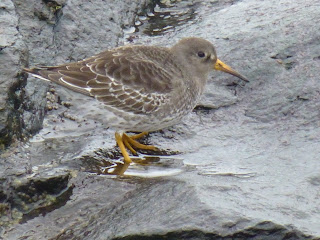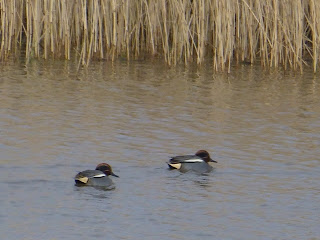Four years ago my coach trip with the Plymouth RSPB group to Slimbridge was cancelled due to snow and ice and I ended up catching the train to Penzance for a days birding instead. And the same thing has happened again!
I arrived in Penzance at around 10:30, having seen a few redwing, a raven and a fox from the train, and it was very cold and grey with a strong and bitter South Easterly wind. A brief search for black redstart on the rocks by the bus station drew a blank but I did see a distant male eider out in the Bay in between the wave troughs.
Walking out to Jubilee Pool and I found just 2 purple sandpipers, very tame and confiding but way down on the usual numbers normally seen here. Offshore there was a distant flock of around 30 common scoters with a great northern diver, again not great views due to the distance and the choppy sea, the scoter flock seeming to be made up entirely of females.
Purple Sandpiper, Jubilee Pool
Purple Sandpiper
Walking along the sea front to Newlyn Harbour I failed to find any black redstarts but a nice adult Mediterranean gull flew along the shoreline, its black summer hood beginning to develop. A grey seal poked its head out of the water a few times quite close to shore and good numbers of turnstones were roosting along the beach in small loose flocks waiting for the tide to turn and go it.
I had excellent views of a great northern diver in Newlyn Harbour but there was no sign of the long staying black necked grebe which I had mistakenly thought would be a dead cert for the day (it was reported on the Cornish sightings webpage that evening too!).
Great Northern Diver, Newlyn Harbour
Great Northern Diver
Great Northern Diver
Heading back to the bus station at Penzance and I finally caught a good but too brief view of a beautiful male black redstart on the boulders along the shore before it flew off and out of sight. I then headed off on the bus to Marazion Marsh, seeing around 100 lapwings feeding in the fields by the roadside, no doubt refugees from the cold weather up country.
Staking out the reedbed at Marazion I failed to see any bitterns this year but I had good views of snipe feeding along the water line and flying around. A sparrowhawk caused chaos amongst them as it hunted over the reedbeds, it was even seen briefly hovering over a clump of reeds as snipe flew out in panic. 2 Cettis warblers were heard and a large flock of around 300 golden plovers were seen flying over in the distance. My pulse quickened briefly when I saw some large birds flapping in the reeds but they turned out to roosting grey herons. Teal also showed very well and despite the cold were busily calling and displaying in small groups.
Snipe, Marazion Marsh
Male Teal, Marazion Marsh
Along the beach I found an adult common gull and an adult lesser black backed gull amongst the bathing gull flock but there was no sign of the recently reported glaucous gull. A lone dunlin and 5 ringed plover were also seen but were regularly disturbed by walkers along the beach.
Walking back to Penzance to catch the train home and I found a very confiding female black redstart amongst the boulders near the train station and then the male black redstart appeared, giving excellent views and a very nice end to a great day out.
Male Black Redstart, Penzance Railway Station
It is a shame the coach trip was cancelled, I was really looking forward to going and for £23 (transport AND entrance fee) it is a bargain, at least I will get my money back. Looking at doing it by myself by train and taxi it would cost up to £100!





































